The published timings of the train were:-
13:30 depart KalawThis is train 141 booked to leave Thazi at 7.00 a.m. (Which I'd caught in 2016 when travelling from Thazi to Kalay as described in posts Thazi-Kalaw and Thazi - Kalaw (part 2)).
15:40 depart Heho
17:00 arrive Shwenyaung
There was a particular reason I'd chosen to to now make the journey beyond Kalaw to Shwe Nyaung - I'd found out there was a circular loop or spiral, descending in our direction of travel between Heho and Shwe Nyaung. I might have been tempted to catch an ascending train, when the loco would be working hard but travelling on a descending train fitted in better with my overall programme and certainly emphasised the importance of brakes!
Kalaw Station (mileage: 369)
Division 4 of Myanma Railways
Kalaw is the headquarters of Division 4 of Myanma Railways and the Divisional offices face the station across the tracks.
 Kalaw Division Railway Offices stand opposite Kalaw Station.
Kalaw Division Railway Offices stand opposite Kalaw Station.
Map showing extent of Division 4
Click on map for larger view
Layout of Station
I'd first visited Kalaw Station (elevation 4297 feet) in 2016 when I'd arrived at Kalaw by train but I'd also studied the station the following day when travelling around Kalaw by road. In 2017, I first visited the station by road on our arrival on Saturday because my guide, Thandar Oo, wanted to confirm the train timings. So my pictures in the album Kalaw Station consolidates the pictures taken on these various visits. On the Sunday of our train journey to Shwe Nyaung, we arrived at the station nice and early so that I could take more pictures which form the start of the album Kalaw - Shwe Naung by train.
The station is provided with one broad platform situated on the left looking towards Shwe Naung.

Kalaw Station showing the covered waiting area on the broad platform.
There is a main line, passing loop, goods loop and three sidings with stop blocks. Points are controlled from single lever point frames with Trapped Key Interlocking arrangements supervised by the Station Master. Points are equipped with the usual semi-derelict point indicators.
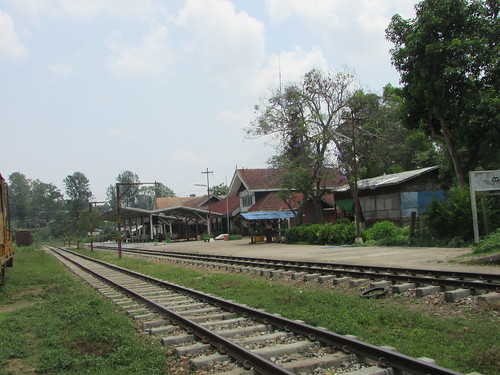
General view of Kalaw Station looking towards Thazi.
An Outer Home signal approaching the station is provided in each direction and both are controlled from a Signal Capstan on the station platform. I'd previously seen these Signal Capstans (which I sometimes called 'windlasses') on the line to Maymyo.
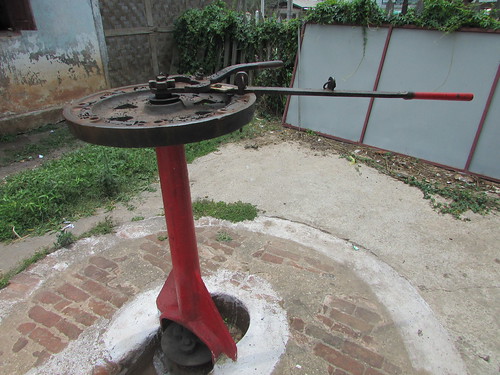
Outer Home Signal Capstan at Kalaw (Up/Down)
The Outer Home signals are preceded by fixed Distant signals. There is a level crossing with manual gates on the Thazi side of the station. Movements over the level crossing and through points are authorised by a green hand signal from the pointsman/crossing keeper.
The usual diagram in the Station Master's office makes the arrangements clearer:-
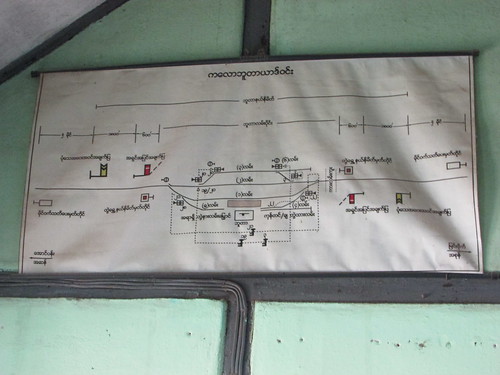
Track diagram in Station Master's office at Kalaw. Shwe Naung is to the left, Thazi to the right.
Click here for larger view
Kalaw: Arrival and Departure of my train
A member of the station staff (whom I'll call the 'pointsman') was despatched to to the Signal Capstan to make sure that the Outer Home was 'clear' for the approaching train, then he carried on to the loop points to check that they were correctly set and 'clipped' (secured with a point clip, similar to a 'G'-clamp, and padlocked), ready to give a 'green' handsignal to the approaching train to authorise the train's entry to the platform. Since there's also a level crossing next to the points, a Crossing Keeper also appeared to push the two hand operated gates across the road after which he also displayed a 'green' handsignal. The 2,000 horse power diesel-electric locomotive and its train slowly bounced over the pointwork and crawled into the platform.
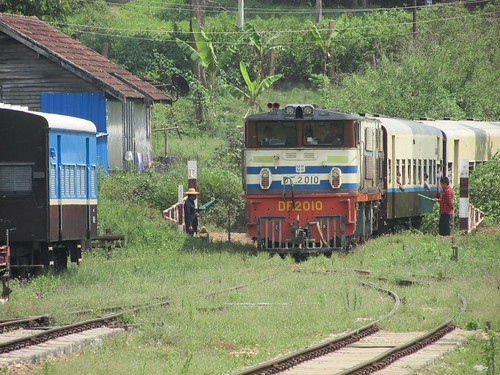
Kalaw - Shwe Naung by train: DF.2010 arriving from Thazi. Pointsman on left, Crossing Keeper on right, both displaying green flags.
Another member of station staff stood ready on the platform to collect a document pouch offered by the Second Man on the locomotive. I assume the pouch surrendered the 'Line Clear' form which had authorised departure from the previous Block Station.

Kalaw - Shwe Naung by train: My train arriving at Kalaw late at 14:57.
I'd not seen a document pouch in use previously. A cane 'hoop' is more common, as shown below.
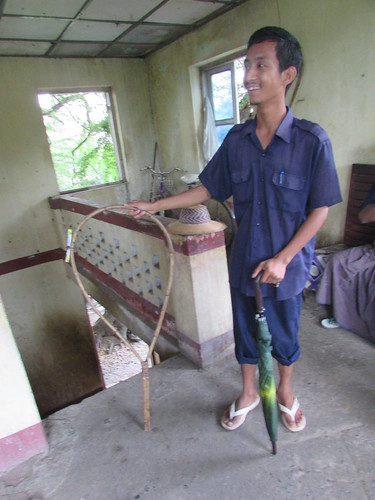
Myo Haung Signal Cabin, Mandalay: A railwayman displays the cane hoop with the vital Paper Line Clear Form attached. This form is issued by the Controller and, when received by the driver, authorises the train movement.
The train comprised four bogie coaches and two bogie goods vans, one with 'duckets' (a part-glazed lookout used by the guard). There was the usual flurry of activity as passengers boarded and alighted and freight was loaded and unloaded. After a plaintive sounding of the locomotive air horn, we quietly departed.
Track maintenance gang
Not long after leaving Kalaw, we slowed right down passing a Permanent Way gang, apparently carrying out spot replacement of rotten wooden sleepers with reinforced concrete ones.
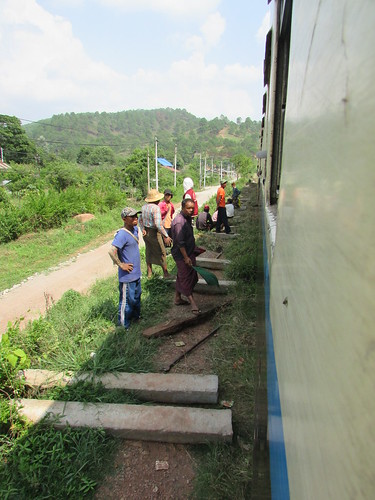
Track Repairs.
The line to Aung Ban
The line twisted and turned over the undulating route across the mountains meaning that our locomotive was working quite hard at times.
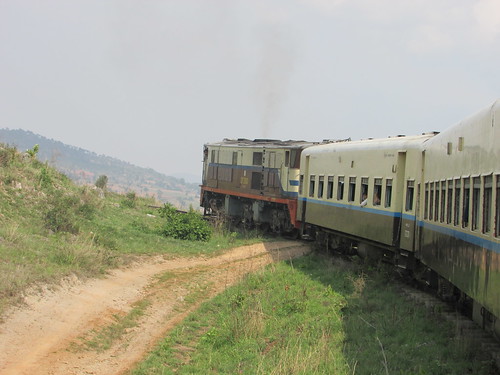
Kalaw - Shwe Naung by train.
Aung Ban Station (mileage: 376)
Our first stop was at Aung Ban (elevation 4219 feet, just 78 feet lower than Kalaw Station). As at Kalaw, approaching the station in each direction there is a fixed Distant signal. The design of these varies quite a bit from site to site.

Kalaw - Shwe Naung by train: Aung Ban semaphore fixed distant.
The distant is followed by an Outer Home signal the design of which can vary. Both upper-quadrant and lower quadrant arrangements are in use.
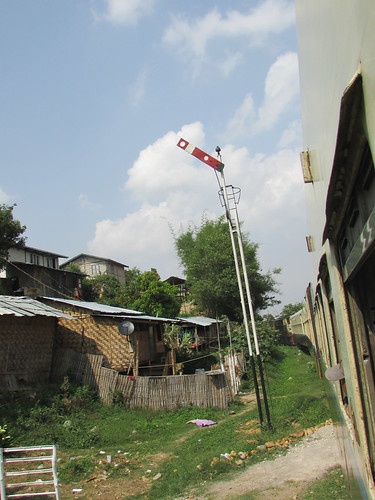
Kalaw - Shwe Naung by train: Aung Ban upper-quadrant semaphore stop signal.
I'd visited Aung Ban by road four days previously, on my way from Heho Airport to Loikaw. In addition to the main line and passing loop, there are four siding loops, plus the diverging branch line to Loikaw. At the Kalaw end of the station, there's a large water tank on a steel truss support to feed a derelict water column, with a swan-neck cast delivery pipe.
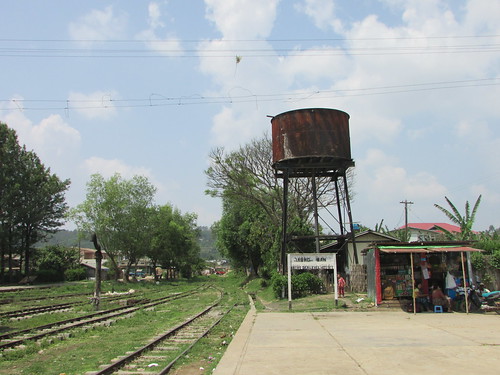
Aung Ban Station: Derelict water column and steel water tower.
Track 4 stabled a coach and an old bogie goods van probably used by railway workers as they were next to Railway Gang Car ED/RGC113 used for track maintenance.
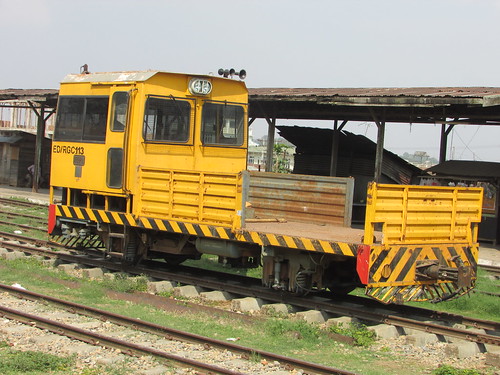
Kalaw - Shwe Naung by train: Railway Gang Car ED/RGC113 at Aung Ban.
After a brief stop, we set off again.

Kalaw - Shwe Naung by train: Leaving Aung Ban, showing sidings on the left and single platform on the right. Note the single lever point frame.
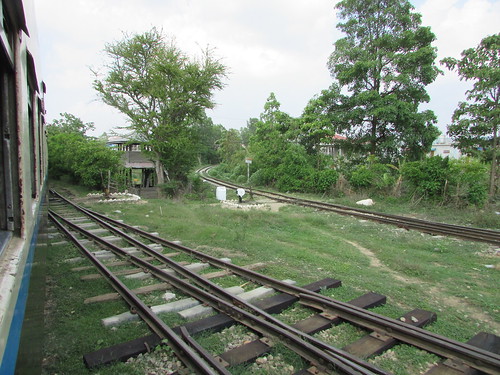
Kalaw - Shwe Naung by train: Leaving Aung Ban, showing branch to Loikaw diverging, two single lever point frames and a point indicator. Note raised hut.
Once again, we were in countryside, sometimes twisting and turning around hills, sometimes overlooking grazing herds and, at least once, passing over a watercourse on a steel girder bridge set on tall stone piers before reaching Kan Na.
Kan Na Station (mileage: 384.75)
We stopped briefly at the rural station of Kan Na. I was surprised to see a lower-quadrant semaphore 'stop' signal beyond the platform, obstinately at 'danger', even as we drew up to the signal. Presently, a pointsman cleared the signal (arm pointing downwards, as you'd expect a lower quadrant to do) and we departed. The signal was protecting a facing point leading to a short siding with a stop block, so I concluded at the time that we were about to descend a reasonably severe gradient but, lacking a gradient diagram, I can't be certain..

Kalaw - Shwe Naung by train: Passing Kan Na semaphore fixed distant.
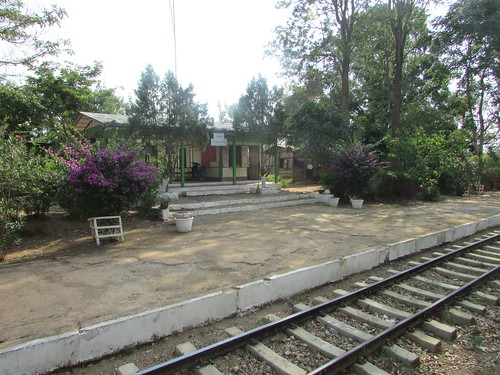
Kalaw - Shwe Naung by train: Kan Na station.

Kalaw - Shwe Naung by train: Kan Na station showing semaphore stop signal with Trapped Key locking box, point indicator, hand point lever and separate warning sign.
As we continued towards Heho, the scenery was initially quite rugged but then turned into a high plain, with extensive vegetable-growing and villagers tending the crop.
Heho Station (mileage: 404)
We passed Heho Airport on our left and then the fixed semaphore distant for Heho. The Outer Home signal was 'off' and I managed a reasonable picture. A square concrete foundation has two short steel projections to which the signal post is bolted. The post is formed of two parallel channel-sections of different lengths held parallel by bolting-through nicely-cast spacer blocks. Near the base of the signal, a large pulley wheel diverts the signal operating wire vertically up the post. Near the top of the shorter channel section, a lever is pivoted so that the pull of the signal wire on one end of the lever is converted into a push on the solid rod which extends upwards to operate the signal arm. I was amused to note that three weights had been wired to the end of the lever to ensure that the signal arm returns to danger when the signal wire slackens. The arm itself is pivoted near the top of the longer channel-section which is terminated in a neat, cast finial. On this particular example, the signal arm appeared quite elderly - corrugated steel bolted to a cast spectacle and apparently of the pattern used by The Railway Signal Co, where an arm that looks as if designed to be lower-quadrant is arranged as upper-quadrant. The back-blinder was in the correct position (had the signal been illuminated) and spectacle glasses were still intact (both 'clear' but I couldn't determine whether glass, plastic or metal gauze). Variations of this pattern are found all over Myanmar and, as here, they often lack an access ladder. At Heho, this signal is controlled from a signal capstan on the station platform.
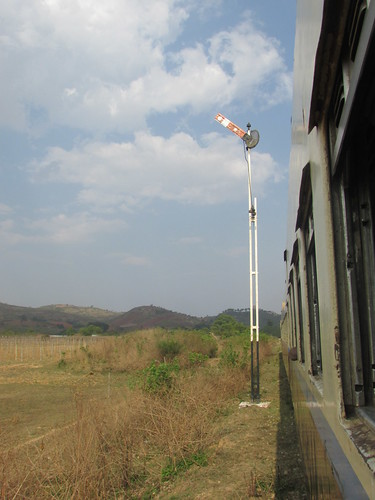
Kalaw - Shwe Naung by train: Semaphore stop signal, Heho.
And so we arrived at Heho where I took plenty of pictures whilst the various vendors plied their wares. Two days later, I made a second visit by road, met the station master and took more pictures (in the album Heho Station). Heho has the main line, passing loop, and one siding loops with moveable scotches (a second siding loop has been abandoned). Points, equipped with point indicators, are controlled from single lever point frames with Trapped Key Interlocking arrangements supervised by the Station Master.
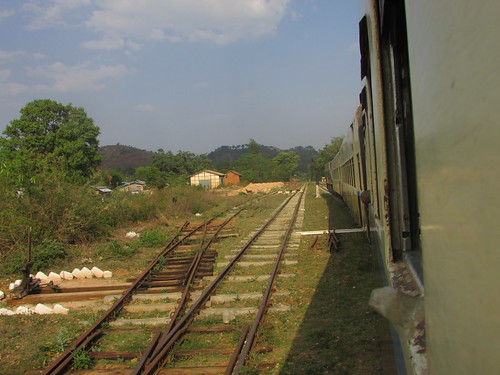
Kalaw - Shwe Naung by train: Entering Heho, showing single lever point frame and abandoned water column.

Kalaw - Shwe Naung by train: Heho.

Kalaw - Shwe Naung by train: Heho Station. Signal Capstan for Up Outer Signal.
During my second visit to Heho station, I was able to photograph the track diagram in the Station Master's Office.
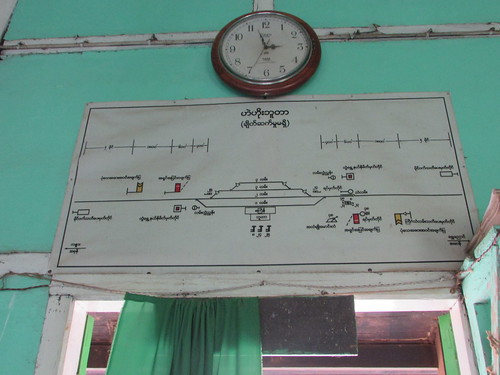
Track diagram in Station Master's Office, Heho. Kalaw is to the left, Shwe Naung to the right.
Click here for larger version.
Unlike, for instance, Kalaw the signal capstan on the platform at Heho only operates the Outer Home Signal for trains heading towards Shwe Nyaung because the Outer Signal heading towards Kalay protects a set of 'trap' points. So, in this case, the signal is operated using a nearby single lever signal frame with Trapped Key locking box shown in the picture below. Again, I assume that this is because the gradient is falling towards Heho but I haven't confirmed this. This signal is similar in design to the other Heho Outer signal illustrated above but, in this case, the 'modern' signal arm has no spectacle, is arranged as an upper-quadrant and is provided with a signal ladder.
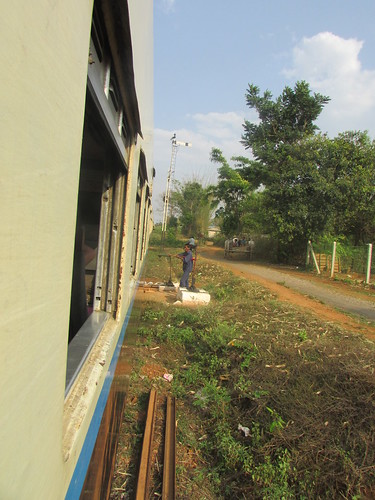
Kalaw - Shwe Naung by train: Leaving Heho, showing semaphore stop signal, single lever signal frame with Trapped Key locking box and Hand point lever for 'trap' points. Note the bullock cart on the roadway.
The Spiral at Ba Wa Sam Sa Ra Bridge
After a lot more twisting and turning to pick our way through the contours of this mountainous area, we came to the Spiral. To lose height rapidly, the railway takes a descending single spiral and crosses under the high level line at the Ba Wa Sam Sa Ra Bridge. After passing a fixed distant, I was not surprised that we came to a 'stop' signal at danger with another fixed distant mounted under the 'stop' arm. This was the last chance for the driver to satisfy himself that the train brakes were operating correctly. Then the signal came 'off' and we gingerly moved forwards.
This was a most curious signal with a short post of channel section painted alternately black and white, rather than white (not that unusual) but with three short lengths of 'rebar' welded to the post, one above the other, to form a ladder. The stop signal arm was corrugated steel, probably old and attached to a spectacle which, from its proportions, was also old. Like the two signals I'd spotted at Kan Na, it was built to be lower-quadrant but, when the handsignalman had 'cleared' the signal, the arm was 'up', not 'down'. As we passed the signal, I looked in vain for any operating mechanism and reluctantly decided the handsignalman had climbed up the 'rebar' to somehow alter the signal aspect. Incidentally, the painted 'vee' on the front of the distant signal arm mounted on the same post was white, not black as usually found in Myanmar although the 'vee' on the rear of the arm was the expected black.
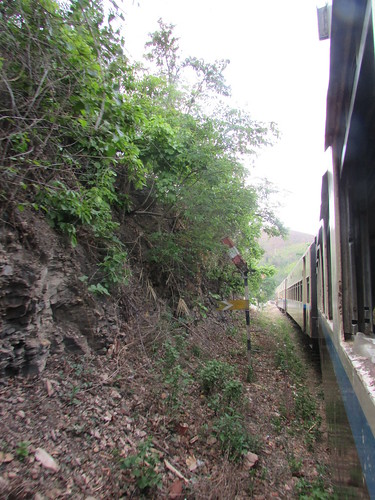
Kalaw - Shwe Naung by train: Semaphore stop signal and fixed distant signal, Ba Wa Sam Sa Ra Bridge.

Kalaw - Shwe Naung by train: View looking back, immediately after passing over the Ba Wa Sam Sa Ra Bridge at high level.
With plenty of braking to control our speed, the train then descended the spiral and passed under the bridge we'd crossed over around three minutes earlier.
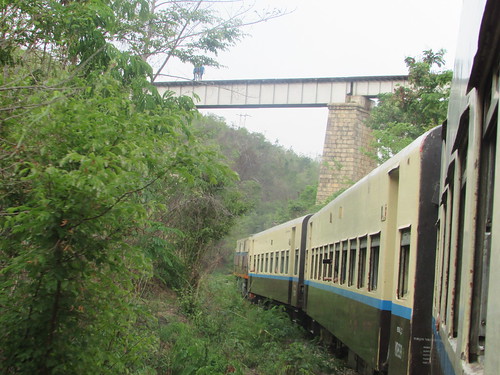
Kalaw - Shwe Naung by train: View looking ahead, immediately before passing under the Ba Wa Sam Sa Ra Bridge at low level.
I was quite impressed by our descent of the spiral.
Shwe Nyaung Station (mileage: 369)
It took us around half an hour to travel from the Spiral to Shwe Nyaung station but, by that time, I was getting fairly tired and didn't pay too much attention, I'm afraid.
Shwer Nyaung has the main line, passing loop, and a couple of siding loops. Points, some equipped with point indicators, are controlled from single lever point frames with Trapped Key Interlocking arrangements supervised by the Station Master.
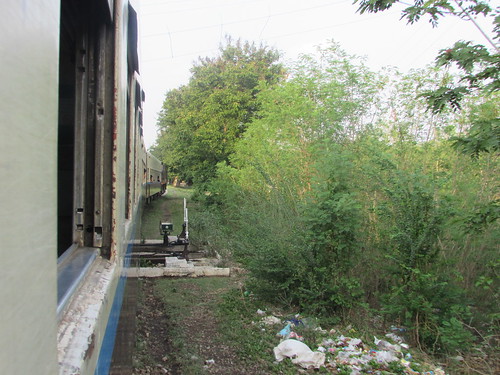
Kalaw - Shwe Naung by train: Arriving at Shwe Naung, with two Single lever point frames, one with point indicator.
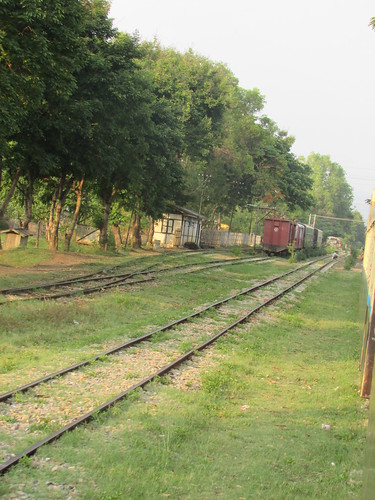
Kalaw - Shwe Naung by train: Arriving at Shwe Naung: L-R: Siding, siding, loop, platform line.
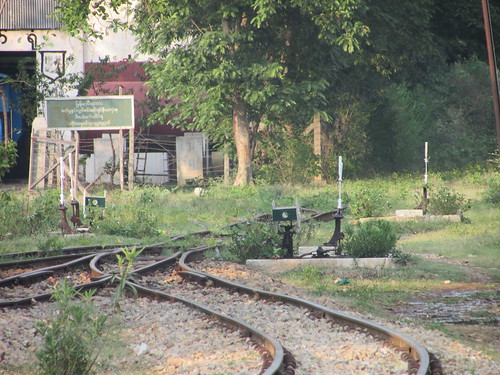
Shwe Naung Station:
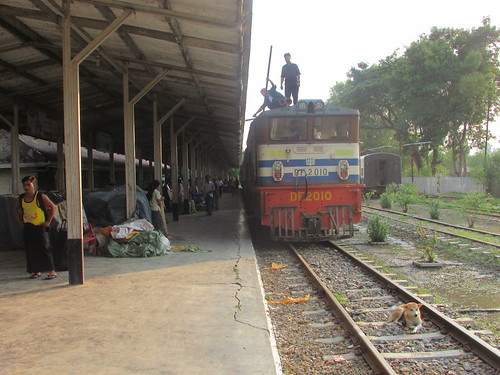
Shwe Naung Station: DF.2010 on arrival. Second man and mechanic on loco roof performing checks (fuel?). Note dog between the rails.
History
History of rail transport in Myanmar (Wikipedia).
Related posts in my blog
On to Inle Lake. All my Myanma Railways posts.
My Pictures
Pictures in this article can be viewed uncropped by clicking on the image. To view in other resolutions or download, select from the albums below:-
Kalaw - Shwe Naung by train.
Kalaw Station (2016, 2017).
Aung Ban Station.
Heho Station.
All my Myanma Railways Pictures.

